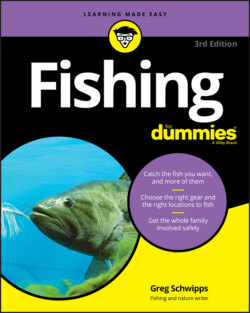Читать книгу Fishing For Dummies - Greg Schwipps - Страница 41
Vests: Great for wading
ОглавлениеVests are such a common sight on streams that it’s hard to imagine wading and fishing without them. Yet until Lee Wulff had the bright idea of sewing some blue jeans pockets onto a denim vest more than 80 years ago, there were no fishing vests. You can buy vests with a gazillion pockets and you can stuff every one of those pockets. And you can also make sure that you have every possible gizmo hanging off the little snaps and rings that many vests have. I know that some of you will because fishing, like every other pastime, has its share of gear freaks (like me). However, I recommend that you take as little as possible in your vest. When wading, it’s advisable to travel light.
Here are the five features to look for in a vest:
Two large outer pockets suitable for holding a box of lures or flies: The pockets should open and fasten from the top. If your vest has pockets that open on the side, you’ll forget to zip up one day and eventually you will lose a box of expensive flies or lures.
Four inner pockets: These are smaller, and it’s okay if they only have Velcro and no zippers. You may put a box of split shot in one pocket, tippet or leader material in another, and bug repellent in another.
Four small outer pockets: One should have a zipper for an extra car key. The rest are for a small box to carry flies, floatant, and this and that.
A metal ring: You can tie your clippers onto this. They do make retractable pin-on gadgets that are designed as clipper holders, but I’ve had bad luck with those gadgets breaking. Save old fly line for these kinds of jobs instead. Tie your clippers on with them. Fly line is also a free alternative to Croakers for holding your sunglasses when you want to keep them handy.
Outside back pouch: Put your rain jacket in here, or maybe your lunch, water bottle, extra reel, and so on.
Now that you have a vest, here are ten things you should always carry in it:
Sunscreen: Use it for all daytime fishing.
Insect repellent: For obvious reasons.
Clippers: For cutting leader and trimming knots, clippers are preferable to teeth because clippers don’t need to go to the dentist.
Thermometer: Many tackle shops sell inexpensive thermometers designed to withstand being tossed about in vests and tackle boxes. With a thermometer, you can tell what species of fish may be most actively feeding.
A plastic garbage bag: You may not keep fish as a rule, but every so often you will want to, and who needs a vest full of fish slime? You don’t need a lawn-size Hefty bag; a wastebasket liner is more like it.
Forceps: They help remove hooks more easily. This is good for the catch-and-release angler who wants to get the fish back in the water in a hurry. And it’s always good for dealing with fish with sharp teeth.
Rain jacket: It doesn’t take up much room and it makes a big difference, especially when it rains!
Spare car key: Everybody loses the car key sometimes. It’s a bummer if this happens when it’s dark and cold by the side of a trout stream 20 miles from home. If you have a key with electronics, keep it in an airtight plastic bag.
Flashlight/headlamp: LED flashlights can be both small and amazingly bright. Headlamps can also be small and bright, and they allow you to keep two hands free for knot tying, removing hooks, and so forth. And at the end of the day, on the way to the car, you can see where you are going.
First aid kit: It’s easy to find a compact first aid kit. Buy one and keep it in your vest at all times. If you’re allergic to bee stings or other insects’ bites, make sure you have something to treat severe allergic reactions.
One last thing: If your cellphone isn't waterproof, carry it in something waterproof. It doesn't have to be fancy; a ziplock sandwich bag will do.
